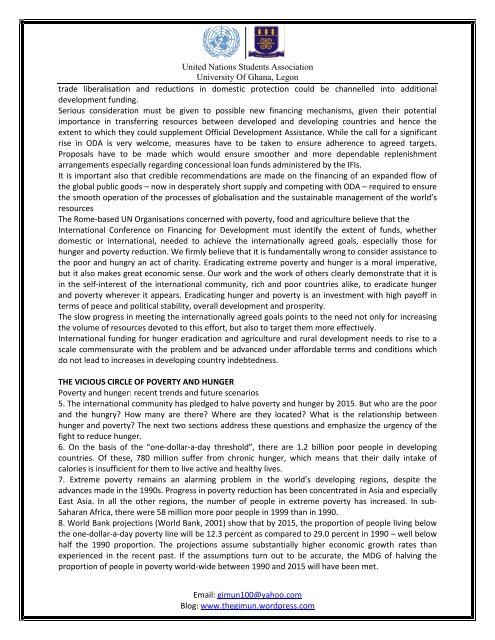United Nations Students Association University Of Ghana, Legon ...
United Nations Students Association University Of Ghana, Legon ...
United Nations Students Association University Of Ghana, Legon ...
You also want an ePaper? Increase the reach of your titles
YUMPU automatically turns print PDFs into web optimized ePapers that Google loves.
<strong>United</strong> <strong>Nations</strong> <strong>Students</strong> <strong>Association</strong><br />
<strong>University</strong> <strong>Of</strong> <strong>Ghana</strong>, <strong>Legon</strong><br />
trade liberalisation and reductions in domestic protection could be channelled into additional<br />
development funding.<br />
Serious consideration must be given to possible new financing mechanisms, given their potential<br />
importance in transferring resources between developed and developing countries and hence the<br />
extent to which they could supplement <strong>Of</strong>ficial Development Assistance. While the call for a significant<br />
rise in ODA is very welcome, measures have to be taken to ensure adherence to agreed targets.<br />
Proposals have to be made which would ensure smoother and more dependable replenishment<br />
arrangements especially regarding concessional loan funds administered by the IFIs.<br />
It is important also that credible recommendations are made on the financing of an expanded flow of<br />
the global public goods – now in desperately short supply and competing with ODA – required to ensure<br />
the smooth operation of the processes of globalisation and the sustainable management of the world’s<br />
resources<br />
The Rome-based UN Organisations concerned with poverty, food and agriculture believe that the<br />
International Conference on Financing for Development must identify the extent of funds, whether<br />
domestic or international, needed to achieve the internationally agreed goals, especially those for<br />
hunger and poverty reduction. We firmly believe that it is fundamentally wrong to consider assistance to<br />
the poor and hungry an act of charity. Eradicating extreme poverty and hunger is a moral imperative,<br />
but it also makes great economic sense. Our work and the work of others clearly demonstrate that it is<br />
in the self-interest of the international community, rich and poor countries alike, to eradicate hunger<br />
and poverty wherever it appears. Eradicating hunger and poverty is an investment with high payoff in<br />
terms of peace and political stability, overall development and prosperity.<br />
The slow progress in meeting the internationally agreed goals points to the need not only for increasing<br />
the volume of resources devoted to this effort, but also to target them more effectively.<br />
International funding for hunger eradication and agriculture and rural development needs to rise to a<br />
scale commensurate with the problem and be advanced under affordable terms and conditions which<br />
do not lead to increases in developing country indebtedness.<br />
THE VICIOUS CIRCLE OF POVERTY AND HUNGER<br />
Poverty and hunger: recent trends and future scenarios<br />
5. The international community has pledged to halve poverty and hunger by 2015. But who are the poor<br />
and the hungry? How many are there? Where are they located? What is the relationship between<br />
hunger and poverty? The next two sections address these questions and emphasize the urgency of the<br />
fight to reduce hunger.<br />
6. On the basis of the “one-dollar-a-day threshold”, there are 1.2 billion poor people in developing<br />
countries. <strong>Of</strong> these, 780 million suffer from chronic hunger, which means that their daily intake of<br />
calories is insufficient for them to live active and healthy lives.<br />
7. Extreme poverty remains an alarming problem in the world’s developing regions, despite the<br />
advances made in the 1990s. Progress in poverty reduction has been concentrated in Asia and especially<br />
East Asia. In all the other regions, the number of people in extreme poverty has increased. In sub-<br />
Saharan Africa, there were 58 million more poor people in 1999 than in 1990.<br />
8. World Bank projections (World Bank, 2001) show that by 2015, the proportion of people living below<br />
the one-dollar-a-day poverty line will be 12.3 percent as compared to 29.0 percent in 1990 – well below<br />
half the 1990 proportion. The projections assume substantially higher economic growth rates than<br />
experienced in the recent past. If the assumptions turn out to be accurate, the MDG of halving the<br />
proportion of people in poverty world-wide between 1990 and 2015 will have been met.<br />
Email: gimun100@yahoo.com<br />
Blog: www.thegimun.wordpress.com


